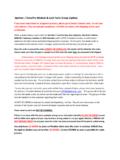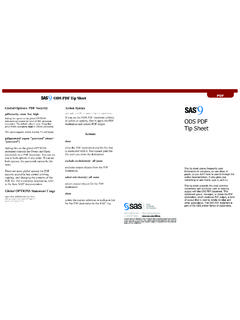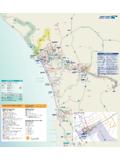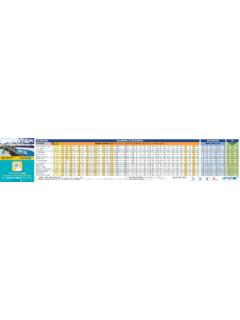Transcription of MATERIAL SAFETY DATA SHEET - uppi-ups.com
1 MATERIAL SAFETY data SHEET I. PRODUCT IDENTIFICATION MANUFACTURER CHEMICAL/TRADE NAME MARATHON and sprinter GNB Industrial Power (as used on label) Valve Regulated Lead Acid Battery A Division of Exide Technologies 3950 Sussex Avenue Aurora, IL 60504-7932 FOR INFORMATION CHEMICAL FAMILY/ Electrical Storage Battery Primary: MACTEC Engineering and Consulting, Inc. CLASSIFICATION Monoblock type Attention: DeLyn Thompson (770) 421-3364 Secondary: Environmental, SAFETY & Health DATE ISSUED: May 4, 2005 Attention: Fred Ganster (610) 921-4052 FOR EMERGENCY CHEMTREC (800) 424-9300 CHEMTREC INTERNATIONAL (703) 527-3887 Collect 24-hour Emergency Response Contact Ask for Environmental Coordinator II.
2 HAZARDOUS INGREDIENTS/IDENTITY INFORMATION Approximate Air Exposure Limits ( g/m3) Components CAS Number % by Wt. OSHA ACGIH NIOSH Inorganic components of: Lead 7439-92-1 71-76 50 50 50 Copper 7440-50-8 < 1000 1000 1000 Tin 7440-31-5 2000 2000 2000 Electrolyte (sulfuric acid) 7664-93-9 16-18 1000 200 1000 Case MATERIAL : Polypropylene 9003-07-0 6-7 N/A N/A N/A Talc (Non-Asbestos Type) 14807-96-6 < 20 mppcf* 2000* 2000 Plate separator MATERIAL : Glass N/A 2-3 N/A N/A N/A *Respirable dust NOTE: Inorganic lead and electrolyte (water and sulfuric acid solution) are the primary components of every battery manufactured by Exide Technologies or its subsidiaries. Other ingredients may be present dependent upon battery type. Polypropylene is the principal case MATERIAL of automotive and commercial batteries.
3 III. PHYSICAL data Boiling Point (Electrolyte) 203 F (at 760 mm Hg) Specific Gravity (H20=1) to Melting Point Not Applicable Solubility in Water 100% Vapor Pressure (mm Hg at 20 C) 10 Evaporation Rate (Butyl acetate=1) Less Than 1 Vapor Density (AIR=1) Greater than 1 Appearance and Odor A clear liquid with a sharp, penetrating, pungent odor. A battery is a manufactured article; no apparent odor. % Volatiles by Weight Not Applicable Z99-MSDS-MARSPR Rev. AD 2005-05 Page 1 of 5 ANY PHOTOCOPY MUST BE OF THIS ENTIRE DOCUMENT Z99-MSDS-MARSPR Rev. AD 2005-05 Page 2 of 5 ANY PHOTOCOPY MUST BE OF THIS ENTIRE DOCUMENT IV. FIRE AND EXPLOSION HAZARD data Flash Point: Not Applicable Flammable Limits: LEL = (Hydrogen Gas in air) ; UEL = Extinguishing media: CO2; foam; dry chemical Special Fire Fighting Procedures: Use positive pressure, self-contained breathing apparatus.
4 Beware of acid splatter during water application and wear acid-resistant clothing, gloves, face and eye protection. If batteries are on charge, shut off power to the charging equipment, but, note that strings of series connected batteries may still pose risk of electric shock even when charging equipment is shut down. Unusual Fire and Explosion Hazards: In operation or when on charge, batteries generate hydrogen and oxygen gases (hydrogen is highly flammable and oxygen supports combustion). They must always be assumed to contain these gases which, if ignited by burning cigarette, naked flame or spark, may cause battery explosion with dispersion of casing fragments and corrosive liquid electrolyte. Carefully follow manufacturer's instructions for installation and service. Keep away all sources of gas ignition, ensure that adequate ventilation is provided, and do not allow metallic articles to simultaneously contact the negative and positive terminals of a battery.
5 V. REACTIVITY data Stability: Stable X Unstable Conditions to Avoid: Prolonged overcharging and overheating current; sparks and other sources of ignition. Incompatibility: (materials to avoid) Electrolyte: Contact of sulfuric acid with combustibles and organic materials may cause fire and explosion. Also reacts violently with strong reducing agents, most metals, carbides, chlorates, nitrates, and picrate, sulfur trioxide gas, strong oxidizers, and water. Contact with metals may produce toxic sulfur dioxide fumes and may release flammable hydrogen gas. Lead compounds: Avoid contact with strong acids, bases, halides, halogenates, potassium nitrate, permanganate, peroxides, nascent hydrogen, potassium, carbides, sulfides, phosphorus, sulfur and reducing agents. Hazardous Decomposition Products: Electrolyte: Sulfur trioxide, carbon monoxide, sulfuric acid mist, sulfur dioxide, hydrogen sulfide, hydrogen.
6 Lead compounds: Temperatures above the melting point are likely to produce toxic metal fume, vapor, or dust; contact with strong acid or base or presence of nascent hydrogen may generate highly toxic arsine gas. Hazardous Polymerization: May Occur Will Not Occur X VI. HEALTH HAZARD data Routes of Entry: Electrolyte: Harmful by all routes of entry. Under normal conditions of use, sulfuric acid vapors and mist are not generated. Sulfuric acid vapors and mist may be generated when product is overheated, oxidized, or otherwise processed or damaged. Lead compounds: Under normal conditions of use, lead dust, vapors, and fumes are not generated. Hazardous exposure can occur only when product is heated above the melting point, oxidized or otherwise processed or damaged to create dust, vapor, or fume.
7 Inhalation: Electrolyte: Breathing of sulfuric acid vapors or mists may cause severe respiratory irritation. Lead compounds: Inhalation of lead dust or fumes may cause irritation of upper respiratory tract and lungs. Ingestion: Electrolyte: May cause severe irritation of mouth, throat, esophagus, and stomach. Lead compounds: Acute ingestion may cause abdominal pain, nausea, vomiting, diarrhea, and severe cramping. This may lead rapidly to systemic toxicity. Acute ingestion should be treated by physician. Skin Contact/Skin Absorption Electrolyte: Severe irritation, burns, and ulceration. Sulfuric acid is not readily absorbed through the skin. Lead compounds: Not readily absorbed through the skin. Eye Contact: Electrolyte: Severe irritation, burns, cornea damage, blindness. Lead compounds: May cause eye irritation. Z99-MSDS-MARSPR Rev.
8 AD 2005-05 Page 3 of 5 ANY PHOTOCOPY MUST BE OF THIS ENTIRE DOCUMENT VI. HEALTH HAZARD data (CONTINUED) Effects of Overexposure - Acute: Electrolyte: Severe skin irritation, burns, damage to cornea may cause blindness, upper respiratory irritation. Lead compounds: Headache, fatigue, abdominal pain, loss of appetite, nausea, vomiting, diarrhea, muscular aches and weakness, sleep disturbances, and irritability. Effects of Overexposure - Chronic: Electrolyte: Possible erosion of tooth enamel; inflammation of nose, throat, and bronchial tubes, and scarring of the cornea. Lead compounds: Anemia; neuropathy, particularly of the motor nerves, with wrist drop; kidney damage; reproductive changes in both males and females. Carcinogenicity: Electrolyte: The National Toxicology Program (NTP) and the International Agency for Research on Cancer (IARC) have classified "strong inorganic acid mist containing sulfuric acid" as a substance that is carcinogenic to humans.
9 This classification does not apply to sulfuric acid solutions in static liquid state or to electrolyte in batteries. Batteries subjected to abusive charging at excessively high currents for prolonged periods of time without vent caps in place may create a surrounding atmosphere of the offensive strong inorganic acid mist containing sulfuric acid. Lead compounds: Listed as a 2B carcinogen, likely in animals at extreme doses. Proof of carcinogenicity in humans is lacking at present. Medical Conditions Generally Aggravated by Exposure: Overexposure to sulfuric acid mist may cause lung damage and aggravate pulmonary conditions. Contact of electrolyte (water and sulfuric acid solution) with skin may aggravate skin diseases such as eczema and contact dermatitis. Contact of electrolyte (water and sulfuric acid solution) with eyes may damage cornea and/or cause blindness.
10 Lead and its compounds can aggravate some forms of kidney, liver, and neurologic diseases. Emergency and First Aid Procedures: Inhalation: Electrolyte: Remove to fresh air immediately. If breathing is difficult, give oxygen. Lead compounds: Remove from exposure, gargle, wash nose, eyes, and lips; consult physician. Ingestion: Electrolyte: Give large quantities of water; do not induce vomiting; consult physician. Lead compounds: Consult physician immediately. Skin: Electrolyte: Flush with large amounts of water for at least 15 minutes; remove contaminated clothing completely, including shoes and do not wear clothes again until cleaned. If acid is splashed on shoes, remove and discard it they contain leather. Lead compounds: Wash immediately with soap and water. Lead compounds are not readily absorbed through the skin. Eyes: Electrolyte and Lead compounds: Flush immediately with large amounts of water for at least 15 minutes; consult physician immediately.







